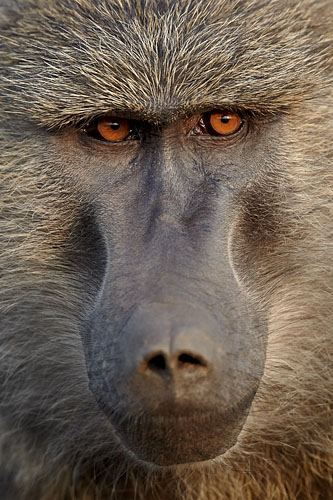Home > Blog > November 2, 2011 – Olive Baboon in Serengeti National Park, Tanzania, and It's All About The Eyes
November 2, 2011
Olive Baboon in Serengeti National Park, Tanzania, and It's All About The Eyes

Olive Baboon
Serengeti National Park, Tanzania
Canon EOS 1D Mk IV, 500 f4 & 1.4x III, 1/180 sec, f5.6, ISO 640
Image taken on February 11, 2011.
It's All About The Eyes
An animal's eyes are a very important part of a wildlife image because the viewer will look at the subject's eye very soon if not first. If the subject's eyes look good, then so will the overall image. Two things are needed to make the subject's eyes look good.First, the eyes must be in focus. If the eyes appear sharp, then the overall image will look sharp even if there's not enough depth of field for the whole image to be sharp like in the image of the baboon above. The baboon's eyes are sharp and that makes the image look in focus even though the tip of his nose is out of focus. If the subject's eyes aren't in the same plane, then the eye closest to the viewer should be in focus. There are four ways to achieve proper focus on the eye(s).
- Manually select an AF (autofocus) sensor that when placed on an eye will create a nice composition.
- Use back button focus* to focus using a single AF sensor, then recompose to make the image.
- Manually focus.
- Use all AF sensors and hope your camera body focuses on the eye(s).
Second, the eyes should be pointed in a natural position. In general, the eyes should be pointed in the same direction as the head because it looks odd to have an animal's eyes pointing somewhere other than where its head is pointed. In the image of the baboon above, the head is pointed straight at the viewer and so are his eyes — my favorite orientation. If the head was pointed towards the viewer but the eyes were pointed off to the side, the viewer would wonder what was so interesting over there and not concentrate so much on the subject. Another very effective orientation is for the head and eyes to be pointed at something (way) off to the side of the frame, like a predator looking at some prey in the distance. If the head is pointed off to the side and the eyes are looking at the viewer, then the animal is likely distracted by the photographer's presence and it reduces the impact of the image.
* Back button focus separates the autofocus operation and shutter release by moving the focus control to a button other than the shutter release. For a stationary subject, place the selected AF sensor (usually the center focus point) over the spot that should be in focus, press the focus button to focus, release the focus button to lock focus, compose, then use the shutter release button to make the exposure without changing the focus.
Categories:
This particular blog entry is www.jameshagerphoto.com/blog/?date=2011-11-02. Visit www.jameshagerphoto.com/blog to view the latest blog entry, and you may click here to create a URL that you can bookmark to go to the latest blog entry.
Responses
| November 2, 2011, 3:25 PM by LesleyO |
James, this shot is spectacular. |
New responses are closed.




